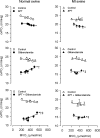Alterations in vasomotor control of coronary resistance vessels in remodelled myocardium of swine with a recent myocardial infarction
- PMID: 18320249
- PMCID: PMC2329737
- DOI: 10.1007/s11517-008-0315-1
Alterations in vasomotor control of coronary resistance vessels in remodelled myocardium of swine with a recent myocardial infarction
Abstract
The mechanism underlying the progressive deterioration of left ventricular (LV) dysfunction after myocardial infarction (MI) towards overt heart failure remains incompletely understood, but may involve impairments in coronary blood flow regulation within remodelled myocardium leading to intermittent myocardial ischemia. Blood flow to the remodelled myocardium is hampered as the coronary vasculature does not grow commensurate with the increase in LV mass and because extravascular compression of the coronary vasculature is increased. In addition to these factors, an increase in coronary vasomotor tone, secondary to neurohumoral activation and endothelial dysfunction, could also contribute to the impaired myocardial oxygen supply. Consequently, we explored, in a series of studies, the alterations in regulation of coronary resistance vessel tone in remodelled myocardium of swine with a 2 to 3-week-old MI. These studies indicate that myocardial oxygen balance is perturbed in remodelled myocardium, thereby forcing the myocardium to increase its oxygen extraction. These perturbations do not appear to be the result of blunted beta-adrenergic or endothelial NO-mediated coronary vasodilator influences, and are opposed by an increased vasodilator influence through opening of K(ATP) channels. Unexpectedly, we observed that despite increased circulating levels of noradrenaline, angiotensin II and endothelin-1, alpha-adrenergic tone remained negligible, while the coronary vasoconstrictor influences of endogenous endothelin and angiotensin II were virtually abolished. We conclude that, early after MI, perturbations in myocardial oxygen balance are observed in remodelled myocardium. However, adaptive alterations in coronary resistance vessel control, consisting of increased vasodilator influences in conjunction with blunted vasoconstrictor influences, act to minimize the impairments of myocardial oxygen balance.
Figures











Similar articles
-
Integrative control of coronary resistance vessel tone by endothelin and angiotensin II is altered in swine with a recent myocardial infarction.Am J Physiol Heart Circ Physiol. 2008 May;294(5):H2069-77. doi: 10.1152/ajpheart.01163.2007. Epub 2008 Feb 29. Am J Physiol Heart Circ Physiol. 2008. PMID: 18310517
-
Prostanoids suppress the coronary vasoconstrictor influence of endothelin after myocardial infarction.Am J Physiol Heart Circ Physiol. 2011 Sep;301(3):H1080-9. doi: 10.1152/ajpheart.01307.2010. Epub 2011 Jun 17. Am J Physiol Heart Circ Physiol. 2011. PMID: 21685265
-
Regulation of coronary blood flow during exercise.Physiol Rev. 2008 Jul;88(3):1009-86. doi: 10.1152/physrev.00045.2006. Physiol Rev. 2008. PMID: 18626066 Review.
-
Contribution of KATP+ channels to coronary vasomotor tone regulation is enhanced in exercising swine with a recent myocardial infarction.Am J Physiol Heart Circ Physiol. 2005 Mar;288(3):H1306-13. doi: 10.1152/ajpheart.00631.2004. Epub 2004 Nov 11. Am J Physiol Heart Circ Physiol. 2005. PMID: 15539425
-
Regulation of coronary resistance vessel tone in response to exercise.J Mol Cell Cardiol. 2012 Apr;52(4):802-13. doi: 10.1016/j.yjmcc.2011.10.007. Epub 2011 Oct 15. J Mol Cell Cardiol. 2012. PMID: 22037538 Review.
Cited by
-
Ventricular remodeling and function: insights using murine echocardiography.J Mol Cell Cardiol. 2010 Mar;48(3):512-7. doi: 10.1016/j.yjmcc.2009.07.004. Epub 2009 Jul 15. J Mol Cell Cardiol. 2010. PMID: 19615377 Free PMC article. Review.
-
'Integrative Physiology 2.0': integration of systems biology into physiology and its application to cardiovascular homeostasis.J Physiol. 2011 Mar 1;589(Pt 5):1037-45. doi: 10.1113/jphysiol.2010.201533. Epub 2011 Jan 4. J Physiol. 2011. PMID: 21224228 Free PMC article. Review.
-
Severe familial hypercholesterolemia impairs the regulation of coronary blood flow and oxygen supply during exercise.Basic Res Cardiol. 2016 Nov;111(6):61. doi: 10.1007/s00395-016-0579-9. Epub 2016 Sep 13. Basic Res Cardiol. 2016. PMID: 27624732 Free PMC article.
-
Cardiovascular remodelling in coronary artery disease and heart failure.Lancet. 2014 May 31;383(9932):1933-43. doi: 10.1016/S0140-6736(14)60107-0. Epub 2014 May 13. Lancet. 2014. PMID: 24831770 Free PMC article. Review.
-
Myocardial perfusion MRI shows impaired perfusion of the mouse hypertrophic left ventricle.Int J Cardiovasc Imaging. 2014 Mar;30(3):619-28. doi: 10.1007/s10554-014-0369-0. Epub 2014 Jan 28. Int J Cardiovasc Imaging. 2014. PMID: 24469738
References
Publication types
MeSH terms
LinkOut - more resources
Full Text Sources
Medical

